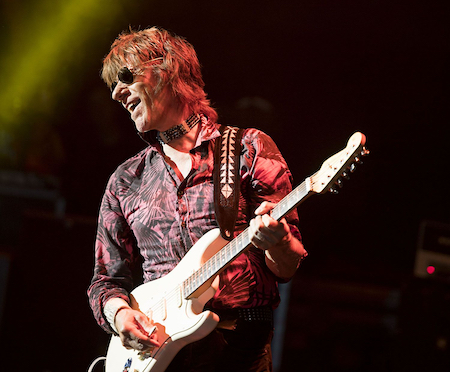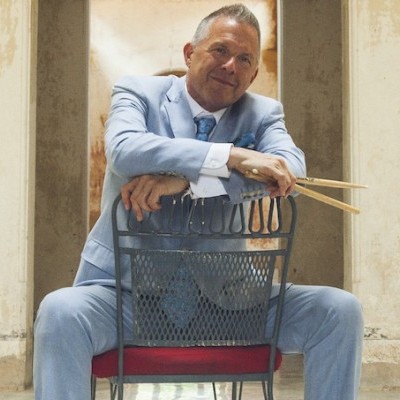Oct 28, 2025 10:47 AM
In Memoriam: Jack DeJohnette, 1942–2025
Jack DeJohnette, a bold and resourceful drummer and NEA Jazz Master who forged a unique vocabulary on the kit over his…

“In the pantheons of guitar players, Jeff was the chosen one,” said Steve Vai of the late Jeff Beck.
(Photo: Ross Halflin)One of an iconic triumvirate of ’60s rock guitar gods, along with Jimi Hendrix and Eric Clapton, Jeff Beck set the template for future guitar virtuosos who would follow in his wake and build on his six-string innovations. Soon after the news came of Beck’s passing on Jan. 10 at age 78 from bacterial meningitis, several of them weighed in on Instagram.
“In the pantheons of guitar players, Jeff was the chosen one,” wrote Steve Vai. “He left us with so much beauty and light in our music world. I can’t imagine the landscape of contemporary guitar playing if he had never been here, but as everything comes and goes in this world, his contribution reshaped our imagination of what the guitar can do forever.”
Added Joe Satriani: “Jeff Beck was a genius, a stunning original. He was an astounding guitar player with more ways to make you go, ‘WTF was that?’ than anybody else. He was profoundly talented, and never stopped innovating on the instrument. He had an enormous impact on my guitar playing, my musicianship and my soul. I found his approach to the instrument so inspiring. His solo albums were all groundbreaking, ahead of their time, and paved the way for me and so many other guitarists around the world.”
A true virtuoso, Beck was one of the rare rock guitarists who eschewed a pick in favor of the independence of fingers on strings to get his signature chord voicings and otherworldly tones. With minimal use of effects, the sound was mostly in his hands. Along with eerie volume knob swells to eliminate the attack on his vicious string-bends — a technique most famously used on his version of the tender Stevie Wonder ballad “‘Cause We Ended As Lovers” from his 1975 album Blow By Blow — Beck also had an unparalleled command of the whammy bar (or tremolo arm) for uncannily precise articulation and liquid inflections that approximated slide guitar or even the human voice (a quality perhaps best exemplified on a lyrical showcase like “Where Were You” from 1989’s Guitar Shop). Another tool in his trick bag was his mastery of high-pitched harmonics, as he demonstrated on the epic “Two Rivers” from Guitar Shop.
Beck discussed his unique technique with writer Gene Santoro in an interview for a January 1985 issue of Guitar World: “It’s more like bluegrass style with rock ’n’ roll in mind. If I break a fingernail, then I have to use a pick, but otherwise I never touch one. With five fingers you can do all kinds of stuff you can’t properly get at with a pick. You can do rolling figures like bluegrass, you can pick out notes of a chord and twang them, push them, bend them, anything you want. When you drop the pick, you’ve got all these fingers hanging out in the breeze. Naturally, you want to use them. Obviously, there are some very fast guitarists, like John McLaughlin, who use a pick. And I can’t even get anywhere near the speed he gets. But that’s not what I’m looking for. I’m looking to use as many notes, chordal things, bends, whatever, that you can’t really do that easily with the same articulation that you get with all separate fingers.”
Several guitarists, like Vai and Satriani, eventually cracked the code of Beck’s playing. But the seven-time Grammy winner and multiple platinum seller continued innovating and delivering passionately over the course of his fabled career.
Born on June 24, 1944, in South London to an accountant father and candy-maker mother, he became attracted to electric guitar after hearing Les Paul’s popular recordings with his wife, singer Mary Ford, in the early 1950s. He was later drawn to the early rockabilly and proto-rock ’n’ roll sound of Gene Vincent, and particularly the group’s guitarist, Cliff Gallup. American blues-rock pioneer Lonnie Mack also became a major guitar influence for young Beck. In 1965, he join The Yardbirds, replacing Eric Clapton in the British rock group. Though he remained with The Yardbirds for only 20 months, his snaky Middle Eastern guitar sound and distortion-laced lines helped define the group’s early hits like “Heart Full Of Soul,” “Over, Under, Sideways, Down” and “Shapes Of Things,” the latter reaching No. 11 on the U.S. pop charts. The band was also immortalized in director Michelangelo Antonioni’s Mod-era film from 1966, Blow Up, which features a scene where the main character (David Hemming’s Thomas) enters a packed nightclub to the strains of The Yardbirds playing a grunge-laden, pre-punk rendition of Tiny Bradshaw’s “The Train Kept A-Rollin’.” During the song, Beck keeps slamming his guitar against his Vox amp out of frustration over a crackling cord, only to ultimately smash it to smithereens on stage before throwing the fragments of the destroyed instrument into the frantic audience (and this a full year before either Hendrix or Pete Townshend smashed their guitars during their sets at the Monterey Pop Festival).
Beck’s landmark debut as a leader, 1968’s Truth, featured Rod Stewart on vocals and included a heavier, more psychedelic version The Yardbirds’ “Shapes Of Things,” along with wah-wah inflected remakes of Willie Dixon’s “You Shook Me” and Howlin’ Wolf’s “I Ain’t Superstitious.” An instrumental number, “Beck’s Bolero,” penned by his Yardbirds bandmate Jimmy Page, became a standard in concert for years to come. He followed in 1969 with Beck-Ola and continued asserting his guitar hero status with 1971’s Rough And Ready and 1972’s Jeff Beck Group.
After applying a light, lyrical touch on the smooth ballad “Lookin’ For Another Pure Love” for Stevie Wonder’s breakthrough 1972 album Talking Book, Beck later recorded Wonder’s “Superstition” on his own 1973 power trio album, Beck, Bogert & Appice, recorded with bassist Tim Bogert and drummer Carmine Appice from the ’60s rock band Vanilla Fudge.
With 1975’s Blow by Blow — an instrumental album produced by George Martin, who had produced the Mahavishnu Orchestra’s Apocalypse the year before and presided over countless studio sessions with the Beatles before that — Beck did a deep dive into fusion waters. On the strength of funky clavinet-fueled fare like “You Know What I Mean” and “Constipated Duck,” along with a reggae-flavored version of the Beatles’ “She’s A Woman,” a beautifully lyrical version of Wonder’s melancholy ballad “Cause We’ve Ended As Lovers” (which Beck dedicated to fellow guitarist Roy Buchanan), a kinetic shuffle on “Freeway Jam” and a mind-blowing “Scatterbrain” (with Martin providing “Glass Onion” type string arrangements), Blow By Blow became a million-selling, Top Five album. He followed in 1976 with Wired, featuring original Mahavishnu Orchestra keyboardist Jan Hammer and current M.O. drummer Narada Michael Walden. That fusion offering included the fiery “Led Boots” and a tender rendition of Charles Mingus’ “Goodbye Pork Pie Hat.” Beck later toured with Hammer’s band, yielding the album Jeff Beck With The Jan Hammer Group Live, which went Gold in 1977.
During the ’80s, Beck racked up such potent albums as 1980’s There & Back, 1985’s Flash (which included his original frontman Rod Stewart on a soulful version of Curtis Mayfield’s “People Get Ready”) and 1989’s Jeff Beck’s Guitar Shop, a stripped-down power trio outing with keyboardist Tony Hymas and drummer Terry Bozzio that went Gold and also earned him a Grammy for Best Rock Instrumental Performance. That same year, he also toured with Texas-born blues-rock guitar hero Stevie Ray Vaughan in a volatile package billed as “The Fire Meets the Fury.”
Beck did prodigious session work through the ’90s, providing signature solos on albums for Jon Bon Jovi, Roger Waters, Kate Bush, Brian May, Tina Turner, Paul Rodgers, Buddy Guy, Stanley Clarke, John McLaughlin and Will Lee. While 1999’s Who Else! and 2003’s David Torn-produced Jeff represented a detour into techno/electronica, he returned to classic form on 2008’s Live At Ronnie Scott’s with drummer Vinnie Colaiuta, bassist Tal Wilkenfeld and keyboardist Jason Rebello playing exhilarating interpretations of Billy Cobham’s “Stratus,” “Cause We’ve Ended As Lovers,” Scatterbrain,” “Led Boots” and “Goodbye Pork Pie Hat.” Beck showed continued breadth of style with 2010’s Emotion & Commotion, which included an interpretation of “Over The Rainbow” and earned him separate Grammys for Pop Instrumental (Puccini’s “Nessun Dorma”) and Rock Instrumental (“Hammerhead”).
Beck’s 2011 album Rock ’n’ Roll Party: Honoring Les Paul was a salute to his original guitar influence. Performed to a select audience at the intimate Iridium nightclub in New York’s Times Square, this live outing featured faithful renditions of Gene Vincent’s “Crusin’,” Eddie Cochran’s “Twenty Flight Rock” and the rockabilly staple “Double Talking Baby” as well as Henry Mancini’s “Peter Gunn Theme,” Santo & Johnny’s “Sleep Walk,” The Shadows’ “Apache” and the Les Paul & Mary Ford hits “How High the Moon,” “The World Is Waiting For The Sunrise” and “Vaya Con Dios.”
His final album, 18, was a collaboration with actor-guitarist-singer Johnny Depp. That July 2022 release featured Beck’s signature lyrical licks on renditions of Marvin Gaye’s “What’s Going On,” Brian Wilson’s “Caroline, No” and Smokey Robinson’s romantic ballad “Ooo Baby Baby,” along with a taste of electronica on “The Death And Resurrection Show,” a touch of darkness on Lou Reed’s “Venus In Furs” and a bit of catharsis on John Lennon’s “Isolation.” The two celebrities made a successful tour of the States together in October and November of 2022.
Depp was reportedly at Beck’s hospital bedside when the legendary guitarist passed. DB

Jack DeJohnette boasted a musical resume that was as long as it was fearsome.
Oct 28, 2025 10:47 AM
Jack DeJohnette, a bold and resourceful drummer and NEA Jazz Master who forged a unique vocabulary on the kit over his…

Always a sharp dresser, Farnsworth wears a pocket square given to him by trumpeter Art Farmer. “You need to look good if you want to hang around me,” Farmer told him.
Sep 23, 2025 11:12 AM
When he was 12 years old, the hard-swinging veteran drummer Joe Farnsworth had a fateful encounter with his idol Max…

D’Angelo achieved commercial and critical success experimenting with a fusion of jazz, funk, soul, R&B and hip-hop.
Oct 14, 2025 1:47 PM
D’Angelo, a Grammy-winning R&B and neo-soul singer, guitarist and pianist who exerted a profound influence on 21st…

Kandace Springs channeled Shirley Horn’s deliberate phrasing and sublime self-accompaniment during her set at this year’s Pittsburgh International Jazz Festival.
Sep 30, 2025 12:28 PM
Janis Burley, the Pittsburgh International Jazz Festival’s founder and artistic director, did not, as might be…

Jim McNeely’s singular body of work had a profound and lasting influence on many of today’s top jazz composers in the U.S. and in Europe.
Oct 7, 2025 3:40 PM
Pianist Jim McNeely, one of the most distinguished large ensemble jazz composers of his generation, died Sept. 26 at…